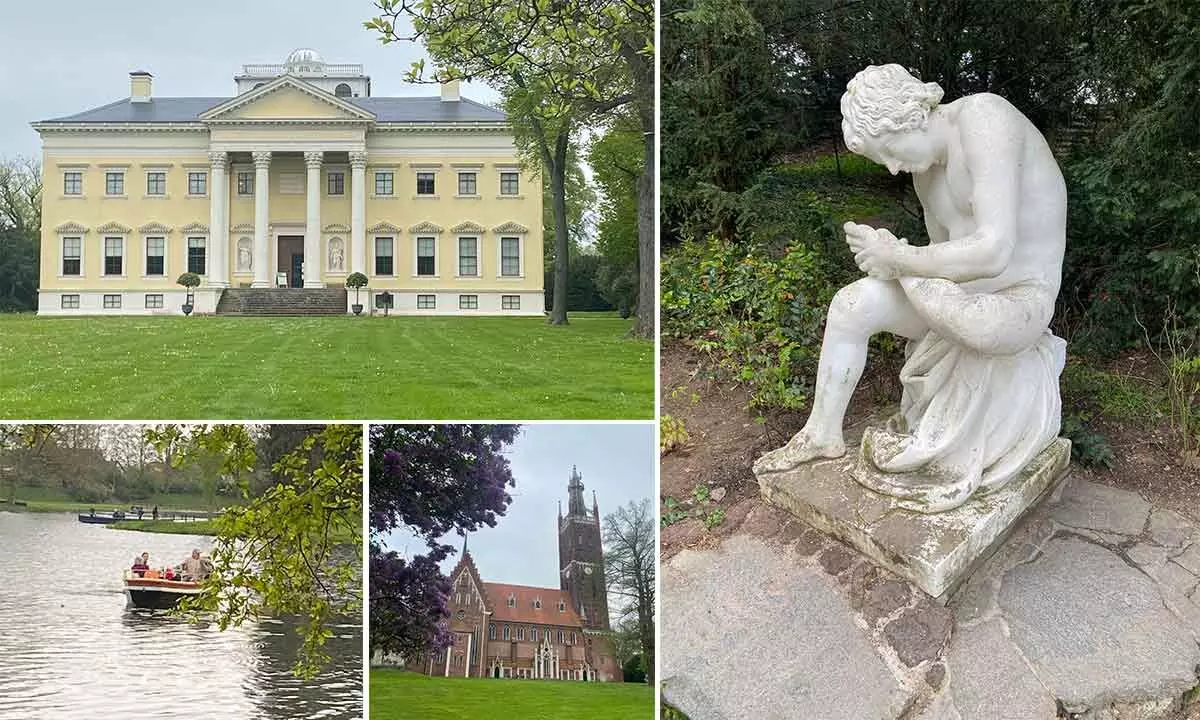The Garden Kingdom of Germany

n the state of Saxony-Anhalt in Germany, between the Elbe and Mulde Rivers, lies the Dessau-Worlitz Garden Kingdom. A spectacular combination of historical gardens, buildings, follies and sculptures it is a UNESCO World Heritage Site. A unique, self-contained landscape of gardens and castles full of beauty and splendour, Dessau-Wörlitzer Gartenreich was created in the 18th century by Prince Leopold III Friedrich Franz and his architect friend Friedrich Wilhelm. Inspired by trips abroad (Italy, England) they were the first to introduce landscape gardening to continental Europe. These gardens spring naturally out of the meadows in bloom, whispering forests, fragrant flowers, glistening lakes and canals. You can walk, hike, cycle, horse-ride or take a ride in a gondola or cruise boat. I chose to take leisurely walks in these gardens and blissful boat rides in Worlitz Lake, all the while admiring the beauty of the spring blossoms.
The creators applied the philosophical principles of the Age of Enlightenment to their landscape design: the result is not only pretty to the eye but also educative. The prince was inspired by the progressive theories on nature and humanism, and by industrial and agricultural developments in England. The park, which was created over the course of 35 years, not only included gardens and buildings but also was associated with fruit growing, agriculture and cattle breeding- a coming together of the useful and the pleasant. In his 59-year reign, the prince succeeded with tolerant policies and enlightened reforms in a country beautification program that is second to none. Using the principle of “usefulness and beauty” as his guide, he planted fruit trees for shade and produce, erected a flood watchtower, and laid down pleasant paths that link tiny villages, creating an enjoyable commute home.
The educational goal of Prince Franz, to open the facilities to all citizens from the very beginning, has remained the case to this day. In the sense of a miniature world with 17 bridges from all over the world, delightful garden paintings, temples, caves and other architectures, the park invites you to travel back in time. The five garden parts are connected by a sophisticated system of visual relationships, paths and canals. At the beginning and end of the visual axes are buildings, sculptures and plantings. Meaningful and unerring, the view is directed into the distance. The garden and building are maintained, renovated and restored to this day.
Wörlitz is by far the most impressive garden of the whole Garden Kingdom consisting of artificial lakes, fields, meadows, forests, and mock Roman temples symbolising classical virtues. There are impressive structures like Worlitz Palace, Gothic House, a temple to Venus modelled after the ancient “Temple of Vesta” in Tivoli, Italy; a Synagogue, a scale model of the Pantheon in Rome, the Neo-Gothic St Peter’s Church, Amalia’s Grotto and even an artificial volcano- the erupting model of Mount Vesuvius bringing a piece of Naples to Germany! Unlike other English gardens, which are designed for hunting for the aristocracy, these gardens are designed for the public to enjoy and experience things, which otherwise they would never get to see.
As an incomparable cultural landscape, the Gartenreich Dessau-Wörlitz stands for the harmony of nature, architecture and visual arts and is an outstanding example of the application of the philosophical principles of the Age of the Enlightenment to the design of a landscape that integrates art, education, and economy in a harmonious whole.
Close to Berlin (less than two hours travel time by road or train), it is certainly worth paying a visit to
these magnificent gardens when you are in Germany next. I am sure you will come back enlightened and exhilarated!

















